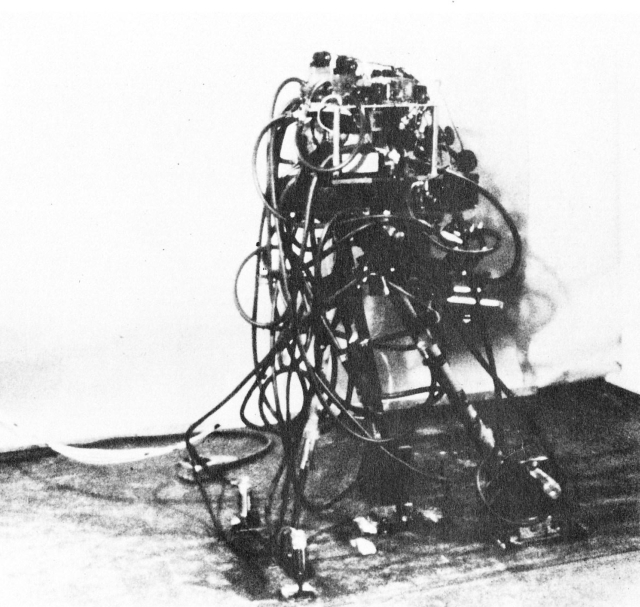
Shown above is the original three legged walking machine.

Contrary to above caption, the 3-legged walker was developed in 1971.
Van Derhei, Jack (ed.) / The Wisconsin engineer
Volume 77, Number 2 (November 1972)
Sanborn, Steve
Everyone should walk, pp. 8-9
During the 1971 Engineering Exposition people on this campus were exposed for the first time to a device we constructed under the guidance of Prof. Seireg of the Mechanical Engineering Department.
This device was a three legged robot powered by compressed air. Actually it was not a complete robot but only the walking portion, just the legs.
The mechanism was constructed to be a model, a mechanical analog of a walking human. It could have been built with only two legs rather than three, but since it weighed 260 pounds it would have damaged easily if tipped over. The third leg provided extra stability.
Since this original prototype was constructed, a new two legged model has been built. The new model differs considerably from the prototype in many respects. The two legged model is powered by AC current rather than compressed air. Unlike the prototype, the present model is actually worn by a human. This was the goal of the design project, to create a device that would give a person that was unable to use his legs, the ability to walk again. The project is by no means completed. More work has to be done in designing and constructing the third model. Presently Jack Grundmann is testing and altering the second model so as to incorporate new ideas into the third mechanism.
As was mentioned, the first prototype was operated with compressed air. This model was consequently bulky and awkward. Model II is operated by what is described as a puppet system. Cables extend from cams, located in a pack, down the body to the individual joints in which they control. The pack is mounted on the shoulder of the person wearing the mechanism. Supports extend from the frame of the mechanism to the pack so that the heavy weight of the device is not felt by the wearer. Within the pack are the six cams that pull the cables causing the person to walk. These cams were designed to cause the joints to move almost exactly the way a normal human moves.
Ultimately it is desired to make a system that will allow a person that can no longer use his legs to walk forward, backward, turn, sit, stand and walk up and down stairs. Also, the device should be cosmetic. This means that it should be possible to cover the mechanism and its suspension system with normal clothing apparel.
Model II can only walk forward, Model III will be able to preform all these tasks. Model III will not be supported by bulky metal braces and tubes as were previous models. Instead, plastics and fiberglass will be incorporated as structural supports. To replace the bulky joints, electronic servo mechanisms will be employed. The use of electronics will allow a number of mini-programs to be place in a very small computer, carried by the person using the device. Each program would cause the mechanism to move, initiating the motions a human makes. The programs would be turned on and off by the person wearing the device. There would be one program for each sequence of movements such as walking or for sitting.
Very little has been done in the past three centuries in the area of prosthesis. The plastic leg of today is nothing more than an adaptation of the wooden leg of the seventeenth century. It is unfortunate that the technology of today has not been applied sooner to help paralyzed people walk again.
This attempt at the University of Wisconsin College of Engineering requires the encouragement and support of all people concerned with restoring the ability to walk to those who cannot.
Note: The exoskeletons mention in the text can be seen here.
See other early Teleoperators, Exoskeletons and Industrial Robots here.